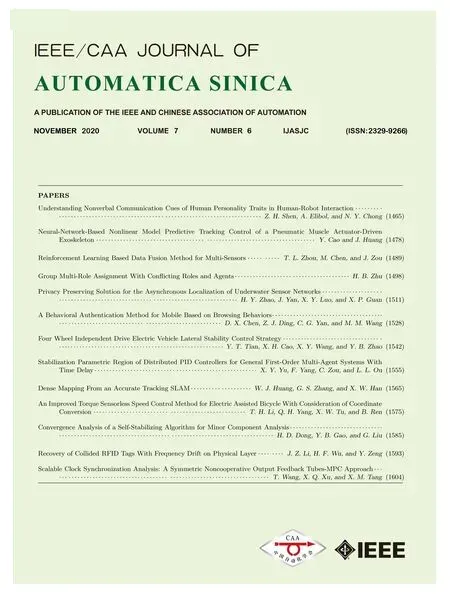Convergence Analysisof a Self-Stabilizing A lgorithm for M inor Component Analysis
Haidi Dong, Yingbin Gao,and Gang Liu
Abstract—The Möller algorithm is a self-stabilizing m inor component analysis algorithm.This research document involves the study of the convergence and dynam ic characteristics of the Möller algorithm using the determ inistic discrete time(DDT)methodology. Unlike other analysis methodologies, the DDT methodology is capable of serving the distinct time characteristic and having no constraint conditions. Through analyzing the dynam ic characteristics of the weight vector,several convergence conditionsare drawn, which are beneficial for itsapplication.The perform ing computer simulations and real applications demonstrate the correctness of the analysis’s conclusions.
I.In t roduction
M INOR componentanalysis(MCA)is termed as a robust instrument in several areas,such as instance frequency estimation[1],total least squares(TLS)[2],and filter design[3].Hebbian neural network oriented MCA algorithms that are capableof adaptively estimating minor components(MCs)from input signals and quickly tracing moving signals have garnered considerable attention[4].Recently,several MCA algorithms have been suggested,such as the Möller algorithm[5],the stable data projectionmethod(SDPM)algorithm[6],the generalized orthogonal projection approximation and subspace tracking (GOPAST)algorithm [7],etc.
For neural network algorithms,oneof the key research tasks involves the analysis of their convergence and dynamic characteristic during all iterations.To the best of our know ledge, three methodologies can be used to accomplish this task.They are the Lyapunov function methodology[2],the determ inistic continuous time(DCT)methodology[8]and the deterministic discrete time(DDT)methodology[9].The Lyapunov function methodology is capable of merely proving whether this algorithm possesses the potential to estimate the desired components or not while being unable to deliver convergence conditions.The DCT methodology requires the mandatory approximation of the learning rate to zero, which is difficult to satisfy in real applications.Contrary to the above two methodologies,the DDT methodology is capable of preserving the distinct time characteristic of the original algorithms and establishing constraint conditionsw ith respect to MCA algorithms.Due to these benefits,the extensive use of the DDT methodology has been applied for analyzing the convergence characteristic of some algorithms[10],[11].
In[5],Möller proposed an MCA algorithm(denoted as the Möller algorithm as follows).Through analyzing the characteristics of its weight vector norm,Möller proved that this algorithm is self-stabilizing.By changing the weight vector into a weight matrix and adding a diagonalmatrix to the Möller algorithm,Gaoet al.[12] modified this algorithm into a multiple m inor component extraction algorithm.The convergence analysis of the Möller algorithm was finished through the DCTmethodology in[13].Asmentioned above,the DDT methodology ismore advantageous than the DCT methodology.Therefore,we sought to analyze the Möller algorithm through theDDTmethodology.
The organization of the remainder of this document is as follows.Section II presents several prelim inaries and a concise description of the Möller algorithm.Section III analyzes the convergence and dynamic characteristics of the Möller algorithm and derivessome convergence conditions.In Section IV, two computer simulationsand two realapplication experiments are conducted to confirm the correctness of the obtained conclusions.Ultimately,we present the study’s conclusions in Section V.
II.Prel imina r ies and Möl ler A lgor ithm

The DDT system of theMöller algorithm can be formulated by the follow ing steps[9].By incorporating the conditional

III.Convergence and Dynamic Cha racter istic Ana lysisof Möl ler A lgor ithm



A. Dynamic Trajectoriesof Möller Algorithm



Fig.1.Convergence of the component .
B. Divergency Experiment


Fig.2.Divergence of the component .
C. Data Fitting Experiment
There are extensive latentapplications of MCA algorithms,and one of the significant ones solves the fitting issue.We have delivered one surface fitting example in this experiment for show ing the efficacy of theMöller algorithm subject to the attained conditions.Let us take into consideration the follow ing curved surface.



Fig.3.Original surface.

Fig.4. Noise disturbed data set.



Fig.5.Convergence of theweight vector elements.
D. Filter Coefficients Estimation Experiment


Fig.6.Structureof the finite impulse response (FIR)filter.


Fig.7.Dynamic trajectoriesof the elementsof h.
V.Conc lusions
As a self-stabilizing MCA algorithm,the Möller algorithm has been applied in various areas.In this research document,we have established the dynam ic characteristic and convergence analysis of the Möller algorithm using the DDT methodology.First,it is verified that the DDT system of the Möller algorithm is bounded.Second,the dynamic trajectories of the weight vector projection are depicted.Third, based on the derived lemmas,we prove that after sufficient iterations,the weight vector must converge to the direction of the desired MC.Finally,computer simulations and real applications validate theprecision of the attained conclusions.
Appendix A Proof of Theorem 1


Appendix B Proof of Theorem 2

Appendix C Proof of Lemma 1




 IEEE/CAA Journal of Automatica Sinica2020年6期
IEEE/CAA Journal of Automatica Sinica2020年6期
- IEEE/CAA Journal of Automatica Sinica的其它文章
- Parallel Control for Optimal Tracking via Adaptive Dynamic Programming
- Sliding Mode Control for Nonlinear Markovian Jump SystemsUnder Denial-of-Service Attacks
- Neural-Network-Based Nonlinear Model Predictive Tracking Controlof a Pneumatic Muscle Actuator-Driven Exoskeleton
- Single Image Enhancement in Sandstorm Weather via Tensor Least Square
- Understanding Nonverbal Communication Cues of Human Personality Traits in Human-Robot Interaction
- A Behavioral Authentication Method for Mobile Based on Browsing Behaviors
